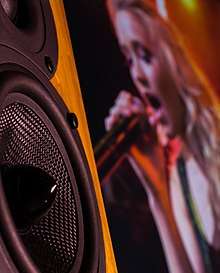Audiovisual

Audiovisual (AV) means possessing both a sound and a visual component, such as slide-tape presentations,[1] films, television programs, church services and live theater productions.
Audiovisual service providers frequently offer web streaming, video conferencing and live broadcast services.[2]
Computer-based audiovisual equipment is often used in education, with many schools and universities installing projection equipment and using interactive whiteboard technology.
Another audiovisual expression is the visual presentation of sound (visual music).
Residential audiovisual
Generally, residential audiovisual encompasses in-ceiling speakers, flat panel TVs, projectors and projector screens. This could include lighting, blinds, cinema rooms.[3]
Commercial audiovisual
The professional audiovisual industry is a multibillion-dollar industry, comprising the manufacturers, dealers, systems integrators, consultants, programmers, presentations professionals and technology managers of audiovisual products and services.
Commercial audiovisual can sometimes be a very lengthy process to get it right. Boardroom audio visual can be installed for a number of reasons, but usually it is because the executives of the organization/business wants to have meetings with colleagues/customers/suppliers around the world. When creating an array of boardrooms for customers it has been seen that you have to be able to balance the pattern from the audio and microphone so there is no interruption in the sound quality for the individual/s listening in.[4]
The proliferation of audiovisual communications technologies, including sound, video, lighting, display and projection systems, is evident in every sector of society: in business, education, government, the military, healthcare, retail environments, worship, sports and entertainment, hospitality, restaurants, and museums. The application of audiovisual systems is found in collaborative conferencing (which includes video-conferencing, audio-conferencing, web-conferencing and data-conferencing); presentation rooms, auditoriums, and lecture halls; command and control centers; digital signage, and more. Concerts and corporate events are among the most obvious venues where audiovisual equipment is used in a staged environment. Providers of this type of service are known as rental and staging companies, although they may also be served by an in-house technology team (e.g., in a hotel or conference center).
According to a 2006 market forecast study by InfoComm International, a leading trade association representing the audiovisual industry, 2006 was the fourth consecutive year that significant growth was projected for the industry. Revenue for surveyed North American companies was expected to grow by 40% in 2006, and by 10.7% for European audiovisual companies. The single biggest factor for this increase is the increased demand for networked audiovisual products due to the integration of audiovisual and IT technology. The two leading markets for AV equipment in North America and Europe continue to be business/IT and education, especially as conference room technologies become more advanced.
Audiovisual education
Audiovisual education is instruction where particular attention is paid to the audio and visual presentation of the material, with the goal of improving comprehension and retention.
See also
References
| Library resources about Audiovisual |